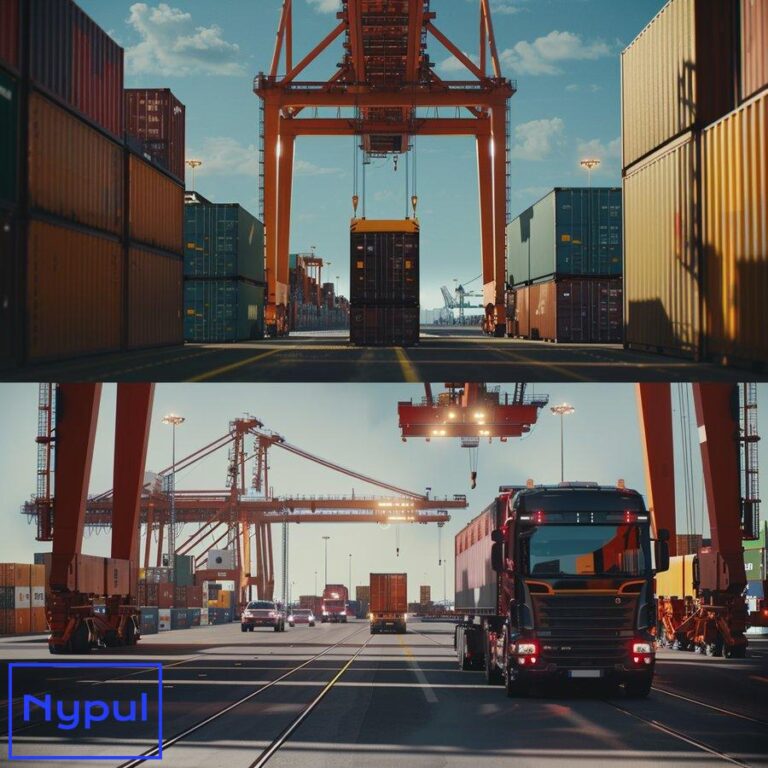How Do You Distribute Weight in Cargo
Why is proper weight distribution crucial in cargo transport?
Proper weight distribution in cargo transport is not just a matter of efficiency; it’s a critical aspect of safety, compliance, and cost-effectiveness. The importance of this practice extends far beyond simply fitting items into a container or truck bed. It impacts every stage of the logistics process, from loading to delivery, and can have significant consequences if not executed correctly.
Safety First
![]()
The primary reason for emphasizing proper weight distribution is safety. An improperly balanced load can lead to catastrophic accidents on the road. When cargo weight is unevenly distributed, it can cause a vehicle to become unstable, increasing the risk of rollovers, jackknifing, or loss of control. This is particularly dangerous for large commercial vehicles like semi-trucks, where the consequences of an accident can be severe.
For instance, if too much weight is concentrated at the rear of a trailer, it can cause the front wheels of the truck to lift off the ground, reducing steering control. Conversely, if the weight is too far forward, it can put excessive pressure on the steering axle, making the vehicle difficult to maneuver.
Regulatory Compliance
Adhering to proper weight distribution practices is not just a best practice; it’s often a legal requirement. Many countries and jurisdictions have strict regulations governing the distribution of weight in commercial vehicles. These rules are designed to protect road infrastructure, ensure vehicle safety, and maintain fair competition in the transport industry.
Violating these regulations can result in hefty fines, vehicle impoundment, and even the suspension of operating licenses. For logistics companies, repeated violations can damage their reputation and lead to loss of business.
Fuel Efficiency and Environmental Impact
Proper weight distribution can significantly impact fuel consumption. When a vehicle’s weight is evenly distributed, it requires less energy to move and maintain speed. This translates to improved fuel efficiency, which not only reduces operational costs but also minimizes the environmental impact of transport activities.
Studies have shown that optimizing load distribution can lead to fuel savings of up to 3-5% in long-haul trucking operations. Over time, these savings can add up to substantial reductions in both fuel costs and carbon emissions.
Vehicle Maintenance and Longevity
The way cargo weight is distributed affects various components of the transport vehicle. Uneven weight distribution can lead to accelerated wear and tear on tires, suspension systems, and brakes. This not only increases maintenance costs but can also shorten the overall lifespan of the vehicle.
For example, overloading the front axle can cause premature wear on steering components and front tires. Similarly, excessive weight on one side of the vehicle can lead to uneven tire wear and suspension problems. By distributing weight properly, fleet operators can extend the life of their vehicles and reduce maintenance expenses.
Cargo Protection
Proper weight distribution is crucial for protecting the cargo itself. When items are stacked or arranged incorrectly, they can shift during transit, leading to damage. This is particularly important for fragile or high-value goods that require special handling.
By distributing weight evenly and securing items properly, shippers can minimize the risk of cargo damage. This not only ensures that goods arrive in perfect condition but also reduces the costs associated with insurance claims and customer dissatisfaction.
Operational Efficiency
Efficient weight distribution contributes to smoother loading and unloading processes. When cargo is well-organized and balanced, it’s easier for warehouse staff and drivers to handle. This can significantly reduce loading times and improve overall operational efficiency.
Moreover, proper weight distribution allows for maximum utilization of cargo space. By optimizing how items are arranged, shippers can often fit more goods into a single shipment, reducing the number of trips required and lowering transportation costs.
Road and Infrastructure Preservation
The impact of improperly distributed cargo weight extends beyond the vehicle itself. Overloaded axles can cause significant damage to roads, bridges, and other infrastructure. This is why many jurisdictions have strict axle weight limits and require vehicles to stop at weigh stations.
By adhering to proper weight distribution practices, the transport industry plays a role in preserving public infrastructure. This, in turn, helps to maintain smooth and safe road conditions for all users.
Customer Satisfaction
Ultimately, proper weight distribution contributes to customer satisfaction. When goods are delivered safely, on time, and in perfect condition, it enhances the reputation of the logistics provider. This can lead to repeat business and positive word-of-mouth recommendations.
In contrast, accidents or delays caused by improper weight distribution can result in unhappy customers and lost business opportunities. In today’s competitive logistics landscape, maintaining high standards in all aspects of cargo handling, including weight distribution, is essential for success.
In conclusion, proper weight distribution in cargo transport is a multifaceted issue that impacts safety, compliance, efficiency, and customer satisfaction. It’s not just about following rules; it’s about implementing best practices that benefit everyone involved in the logistics chain, from drivers and fleet operators to customers and the general public. As we delve deeper into the specifics of weight distribution in the following sections, keep in mind that each aspect contributes to this overarching goal of safe, efficient, and responsible cargo transport.
What are the key weight limits and regulations to consider?

Understanding and adhering to weight limits and regulations is crucial for anyone involved in cargo transport. These rules are designed to ensure safety, protect infrastructure, and maintain fair competition in the industry. Let’s explore the key weight limits and regulations that logistics professionals must consider.
Gross Vehicle Weight Rating (GVWR)
The Gross Vehicle Weight Rating is the maximum weight a vehicle can safely carry, including its own weight, cargo, fuel, and passengers. This rating is set by the manufacturer and is based on the vehicle’s design, including its frame strength, suspension, and braking capacity.
For example, a typical semi-truck might have a GVWR of 80,000 pounds (36,287 kg). It’s crucial never to exceed this limit, as doing so can compromise the vehicle’s safety systems and lead to accidents.
Axle Weight Limits
In addition to the overall weight limit, there are specific limits for each axle of the vehicle. These limits ensure that weight is distributed properly across the vehicle’s structure. Axle weight limits can vary depending on the type of axle (steering, drive, or trailer) and the number of tires on each axle.
For instance, in the United States, the federal weight limits for commercial vehicles on the Interstate Highway System are:
- Single axle: 20,000 pounds (9,072 kg)
- Tandem axle: 34,000 pounds (15,422 kg)
- Gross vehicle weight: 80,000 pounds (36,287 kg)
Bridge Formula
The Bridge Formula is a mathematical formula used to determine the maximum allowable weight for groups of axles at various spacings. This formula is designed to protect bridges from excessive stress caused by heavy vehicles.
The formula takes into account the number of axles and the distance between them. Generally, the more axles a vehicle has and the greater the distance between them, the more weight it can legally carry.
State and Local Regulations
While federal regulations provide a baseline, many states and local jurisdictions have their own weight limit rules. These can be more restrictive than federal limits and may apply to specific roads or bridges.
For example, some states have lower weight limits on certain highways or during spring thaw periods when roads are more susceptible to damage. It’s essential for carriers to be aware of these local variations and plan routes accordingly.
International Regulations
For cross-border transport, it’s crucial to be aware of weight limits and regulations in different countries. These can vary significantly from one nation to another.
For instance, while the maximum gross vehicle weight in the U.S. is typically 80,000 pounds (36,287 kg), in the European Union, it can be up to 88,185 pounds (40,000 kg) for a 5-axle combination. In Australia, road trains can have gross combination masses of up to 199,737 pounds (90,600 kg).
Oversize and Overweight Permits
In some cases, it may be necessary to transport cargo that exceeds standard weight limits. This requires obtaining special permits from relevant authorities. These permits often come with specific conditions, such as restricted routes, time of travel, or additional safety measures.
The process for obtaining these permits varies by jurisdiction, but generally involves submitting detailed information about the load, route, and vehicle to the appropriate regulatory body.
Weighing Requirements
Many jurisdictions require commercial vehicles to stop at weigh stations to ensure compliance with weight regulations. These stations use various technologies to weigh vehicles, including static scales and weigh-in-motion systems.
Failure to stop at a weigh station when required can result in fines and penalties. Some jurisdictions also conduct mobile weighing operations to catch overweight vehicles that might bypass fixed weigh stations.
Cargo Securement Regulations
While not directly related to weight limits, cargo securement regulations are closely tied to weight distribution. These rules specify how cargo must be restrained to prevent shifting during transport.
For example, the Federal Motor Carrier Safety Administration (FMCSA) in the U.S. provides detailed requirements for securing different types of cargo, including the number and strength of tie-downs required based on the cargo’s weight.
Environmental Zones and Low Emission Areas
In some urban areas, particularly in Europe, there are environmental zones that restrict access based on a vehicle’s emissions. While not directly related to weight, these regulations can impact route planning and vehicle selection for cargo transport.
For instance, London’s Ultra Low Emission Zone (ULEZ) requires vehicles to meet certain emission standards or pay a daily charge. This can influence decisions about vehicle types and load consolidation.
Documentation Requirements
Proper documentation is crucial for demonstrating compliance with weight regulations. This typically includes:
- Bills of lading showing cargo weight
- Vehicle registration documents indicating the GVWR
- Permits for oversize or overweight loads
- Weight tickets from certified scales
Carriers must ensure that all required documentation is accurate, up-to-date, and readily available for inspection.
Penalties for Non-Compliance
Violating weight limits and regulations can result in severe penalties. These may include:
- Fines, which can be substantial and may increase for repeat offenses
- Vehicle impoundment
- Suspension of operating licenses
- Criminal charges in cases of severe or repeated violations
The severity of penalties often depends on the degree of overloading and whether it was a first-time or repeat offense.
Understanding and complying with these weight limits and regulations is essential for anyone involved in cargo transport. It requires ongoing education and vigilance, as rules can change and vary by jurisdiction. By staying informed and implementing robust compliance processes, logistics professionals can ensure safe, legal, and efficient cargo transport operations.
How do you accurately calculate cargo weight?
Accurate calculation of cargo weight is a fundamental aspect of efficient and compliant logistics operations. It’s not just about meeting regulatory requirements; precise weight calculations are crucial for optimizing load distribution, ensuring vehicle safety, and maximizing operational efficiency. Let’s explore the methods and considerations for accurately calculating cargo weight.
Individual Item Weighing

The most straightforward method for calculating cargo weight is to weigh each item individually. This approach is particularly useful for shipments with a variety of different items or when dealing with high-value or sensitive cargo.
Process:
1. Use calibrated scales to weigh each item.
2. Record the weight of each item accurately.
3. Sum up the weights of all items to get the total cargo weight.
This method provides the most precise results but can be time-consuming for large shipments.
Pallet Weighing
For shipments that are palletized, weighing entire pallets can be more efficient than weighing individual items.
Steps:
1. Weigh the empty pallet to determine its tare weight.
2. Load the pallet with cargo.
3. Weigh the loaded pallet.
4. Subtract the tare weight of the pallet from the total weight to get the net cargo weight.
5. Repeat for all pallets and sum the results.
This method is faster than individual item weighing and is particularly useful for homogeneous loads.
Vehicle Weighing
For full truckload shipments, weighing the entire vehicle before and after loading can provide an accurate measure of cargo weight.
Process:
1. Weigh the empty vehicle to determine its tare weight.
2. Load the cargo onto the vehicle.
3. Weigh the loaded vehicle.
4. Subtract the tare weight from the loaded weight to calculate the cargo weight.
This method is quick and provides a single weight for the entire shipment, but it doesn’t give information about weight distribution within the vehicle.
Volumetric Weight Calculation
In some cases, particularly for air freight, cargo may be charged based on volumetric weight (also known as dimensional weight) rather than actual weight.
Formula:
Volumetric Weight = Length x Width x Height / Volumetric Factor
The volumetric factor varies by carrier and mode of transport. For example, in air freight, a common factor is 166 cubic inches per pound.
While this method doesn’t provide actual weight, it’s crucial for estimating shipping costs and space requirements.
Load Cell Technology
Modern logistics operations often use load cell technology for real-time weight measurement. Load cells can be integrated into forklifts, pallet jacks, or conveyor systems.
Benefits:
– Provides instant weight readings
– Can be integrated with warehouse management systems for automatic data recording
– Allows for dynamic weight checks during the loading process
This technology is particularly useful in high-volume operations where speed and accuracy are crucial.
Container Weight Verification
For containerized shipments, accurate weight verification is mandatory under the International Maritime Organization’s Safety of Life at Sea (SOLAS) regulations.
Methods:
1. Method 1: Weighing the packed container using calibrated and certified equipment.
2. Method 2: Weighing all packages and cargo items, including pallets and securing materials, and adding the tare weight of the container.
Shippers must provide a verified gross mass (VGM) for each container, which includes both the cargo weight and the container’s tare weight.
Considerations for Accurate Weight Calculation
To ensure the most accurate cargo weight calculations, consider the following factors:
Calibration of Weighing Equipment
Regularly calibrate all scales and weighing equipment to ensure accuracy. This should be done according to manufacturer specifications and any applicable regulations.
Accounting for Packaging Materials
Remember to include the weight of all packaging materials, including boxes, pallets, strapping, and dunnage. These can add significant weight to a shipment.
Moisture Content
Some materials, particularly agricultural products, can absorb moisture, changing their weight over time. Consider this factor when calculating weights for hygroscopic materials.
Temperature Effects
Extreme temperatures can affect the accuracy of some weighing equipment. Ensure that weighing is done in appropriate environmental conditions.
Rounding and Units
Be consistent in how weights are rounded and which units are used. Mixing units (e.g., pounds and kilograms) can lead to errors.
Documentation
Maintain accurate records of all weight calculations, including the method used, date of weighing, and any relevant environmental conditions.
Weight Distribution Calculation
In addition to total weight, it’s crucial to calculate how weight is distributed within the cargo space. This involves determining the center of gravity of the load.
Steps:
1. Divide the cargo area into sections (e.g., front, middle, rear).
2. Calculate the weight in each section.
3. Determine the center of gravity for each section.
4. Calculate the overall center of gravity based on the weight and position of each section.
This information is vital for proper load balancing and vehicle stability.
Using Technology for Weight Calculation
Modern logistics operations often employ advanced technologies to streamline and improve the accuracy of weight calculations:
Warehouse Management Systems (WMS)
WMS software can integrate weight data from various sources, providing real-time visibility into cargo weights and distribution.
Radio-Frequency Identification (RFID)
RFID tags can be used to track individual items or pallets, with weight data associated with each tag.
Automated Guided Vehicles (AGVs)
AGVs equipped with weight sensors can automatically weigh cargo as it’s moved through a warehouse or loading area.
Artificial Intelligence and Machine Learning
These technologies can analyze historical weight data to predict cargo weights for similar shipments, helping to identify discrepancies or potential errors.
Accurate cargo weight calculation is a critical skill in logistics. It requires a combination of proper equipment, consistent processes, and attention to detail. By implementing robust weight calculation methods and leveraging appropriate technology, logistics professionals can ensure compliance with regulations, optimize load distribution, and improve overall operational efficiency.
What are the fundamental principles of effective weight distribution?

Effective weight distribution in cargo transport is a critical aspect of logistics that ensures safety, compliance, and efficiency. Understanding and applying the fundamental principles of weight distribution is essential for anyone involved in the loading and transportation of goods. Let’s explore these key principles in detail.
Center of Gravity
The concept of center of gravity is at the core of effective weight distribution. The center of gravity is the point at which the weight of an object is evenly distributed in all directions.
Key Points:
– In a properly loaded vehicle, the center of gravity should be as low and as centered as possible.





